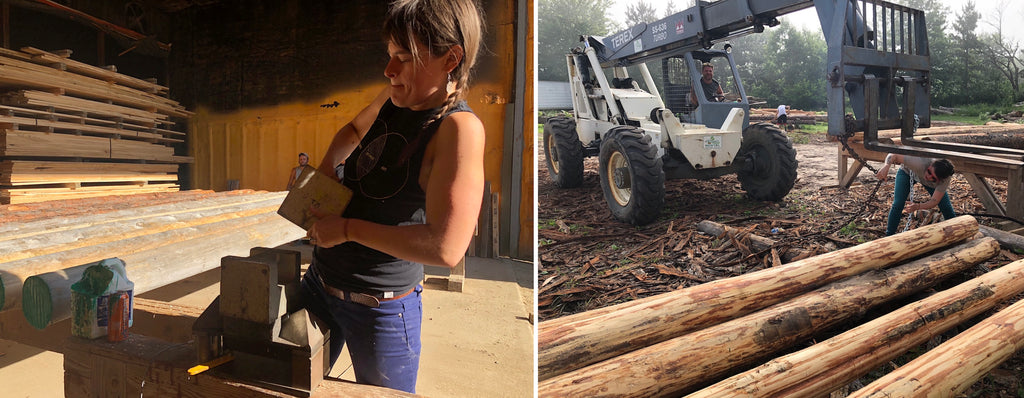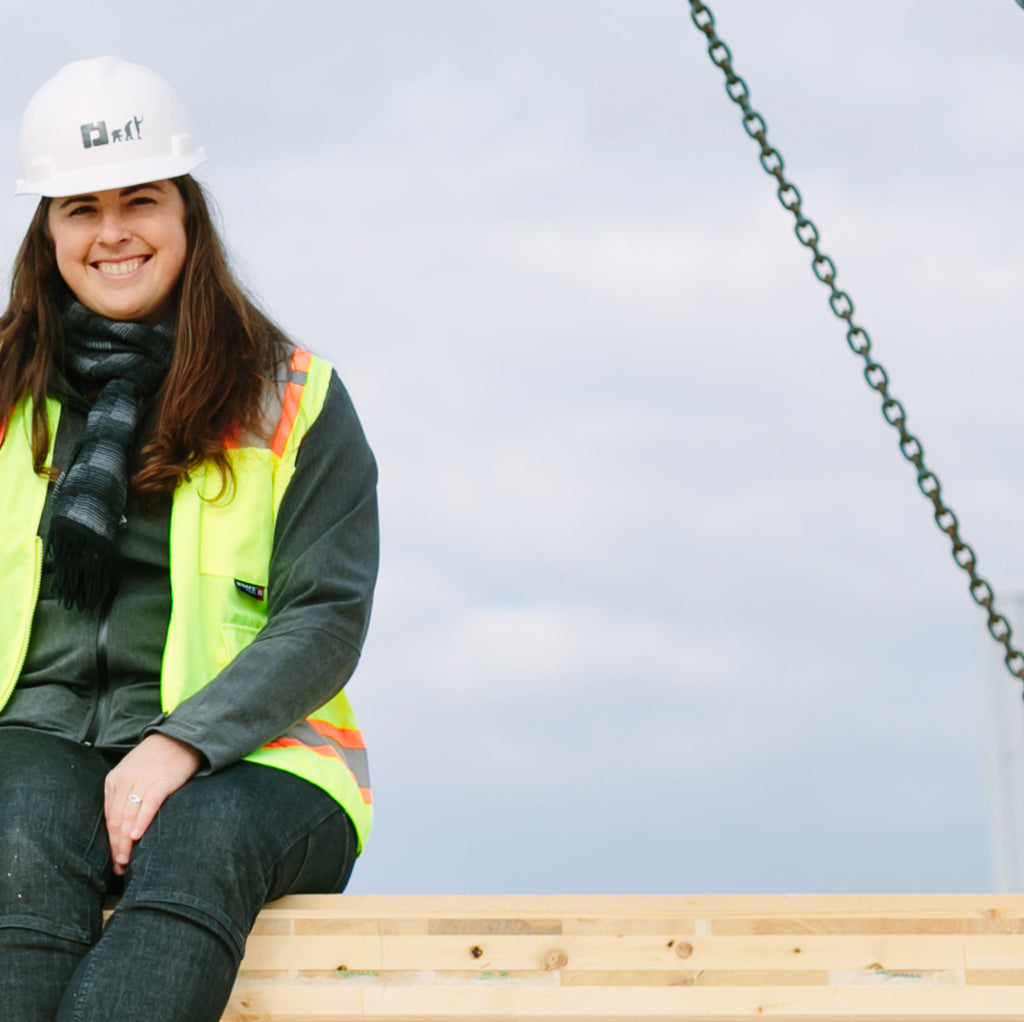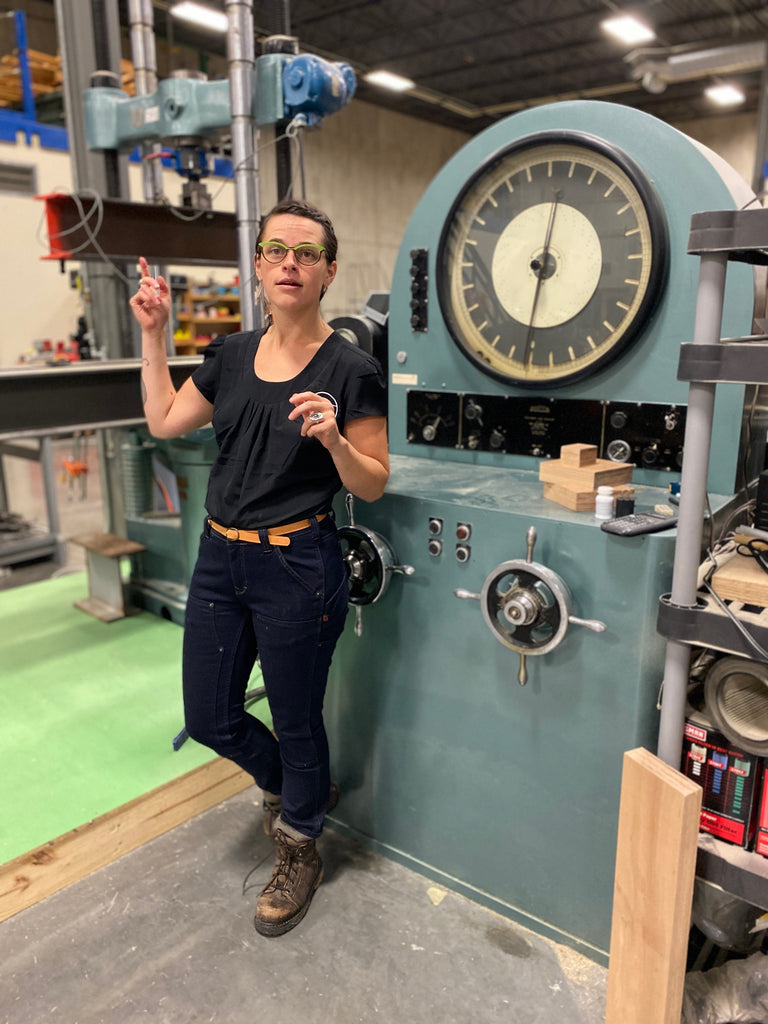Michaela Harms (she/her) PFS TECO Building Products Engineer
Kristin Slavin (she/her) Kaiser + Path Project Architect
Tell us about your work.
MH: My days are always different, which I love. Some scenarios include working with our brilliant lab techs to break material and prove its structural capacities, creating and implementing test programs to provide pathways for innovative products, conducting quality system audits at manufacturing facilities, and educating professionals about sustainable forestry and the wood products industry.

Two of the ways Michaela works it: with finished lumber and the logs they come from.
KS: I bridge architecture and development in our office, often switching between roles. Generally, my role is to keep the big picture of the project in mind and to connect the architecture and construction operations. A recent example of our work is Carbon 12 (in Portland), the tallest modern mass timber building in the US. I was the Lead Architect for that project.
You are both evangelists for building with wood. And we’re not talking a simple cabin here. You’re experts in using engineered sustainable wood products that can do amazing things on a large scale. Educate us!
MH: I am on a relentless campaign to "cure the lorax syndrome." The forestry that supports the wood products industry is largely restorative and a significant solution to mitigating carbon emissions. It runs on a distributed production model that supports local economies. There is so much information out there now to help people understand that we need to create economic incentives for sustainable forest management to keep our forests healthy and thriving. The mass timber industry is doing a great job to rewrite the narrative.
KS: I completely agree. Sustainable forestry is important to all of us, especially foresters working in the field given it is their livelihood. I also want to emphasize the fire resistance properties and strength of wood in buildings. People tend to think of wood as being very flammable, when in reality mass timber at that scale just chars rather than ignites. The charring protects the interior of the wood from the fire, which makes the building very predictable and relatively safe in a fire. It’s also incredibly strong and much lighter than steel or concrete, which has benefits all the way down to the foundation of the building.
Kristin sits on a Cross Laminated Wood plank at the Carbon 12 building. PC: Ashley Courter
What was your educational path to doing what you do?
MH: I graduated early from high school and said NO WAY to traditional college. I'm a kinesthetic learner and need to get my hands dirty to stay interested. I always loved engineering and eventually did end up at a polytechnic university in Helsinki, Finland to study Sustainable Building Engineering. To be honest though, I learned nearly everything I know about engineering in my grandpa's garage as a kid, running around the forest after tornadoes to build shelters from the fallen trees and through the incredible mentors I've had across the industry.
KS: Apparently I knew I wanted to be an architect when I was in middle school, though I don't remember that very well. I took CAD classes in high school and did an internship program as well. I went the more traditional route of college and then grad school, which gave me a great baseline for sustainable design. Once I got into practice I worked for a couple of traditional architecture firms, but wasn't particularly fulfilled. Once I got to Kaiser + Path six years ago—where we do it all and participate much more deeply in our projects—I knew I was in the right place.
What do you want people to know about being a woman in your field?
MH: It sucks, but it's getting better. Never feed into the negativity! Sometimes all I need is a little Cardi B or Municipal Waste in my headphones before entering a male-dominated room, to put my best foot forward. The glass ceiling may be cracking, but the first couple rungs of the ladder are still broken.
KS: Oh the mansplaining... In general women just have to work harder and be smarter and more prepared than men in the room to prove that we are worth listening to, but once that is established, most people in the field are great to work with.
How do you encourage other women to enter engineering/architecture?
Michaela in the PFS TECO Workshop Dovetail Workwear
MH: I’m an active mentor to get not just women, but also a younger generation into our industry. I work with the Women in Science and Engineering group at UW Madison and the Forest Products Society Joint Education Committee. Most often all it takes is helping people look in the mirror and see their amazing gifts. We don't do that enough for each other. I also try to remind the women I work with (and myself) that vulnerability and failure lead to innovation.
KS: I have also focused a lot of my volunteer time supporting emerging professionals in architecture, where there is a more even ratio of women to men than in general practice. I think mass timber is actually providing an avenue for more women to take charge. Innovation is always taken on by the misfits, and in an industry where women only make up 36% of licensed professionals, let alone only about 17% of principals and partners, we are certainly the misfits!


